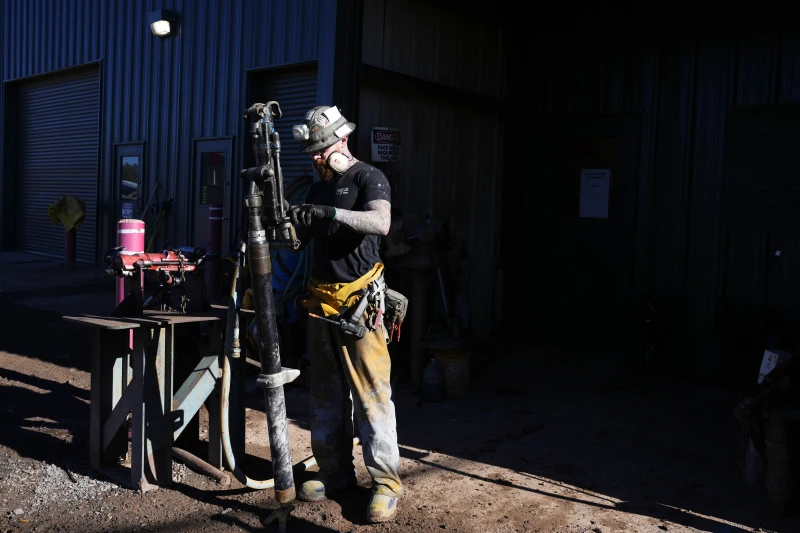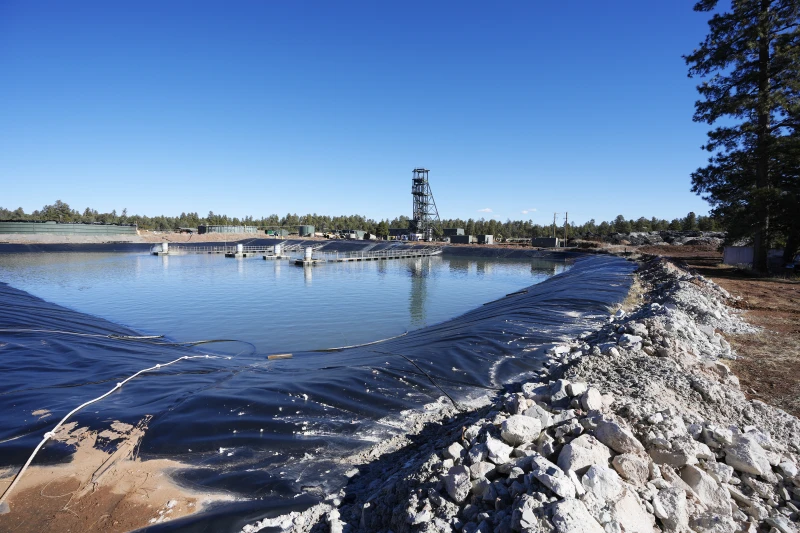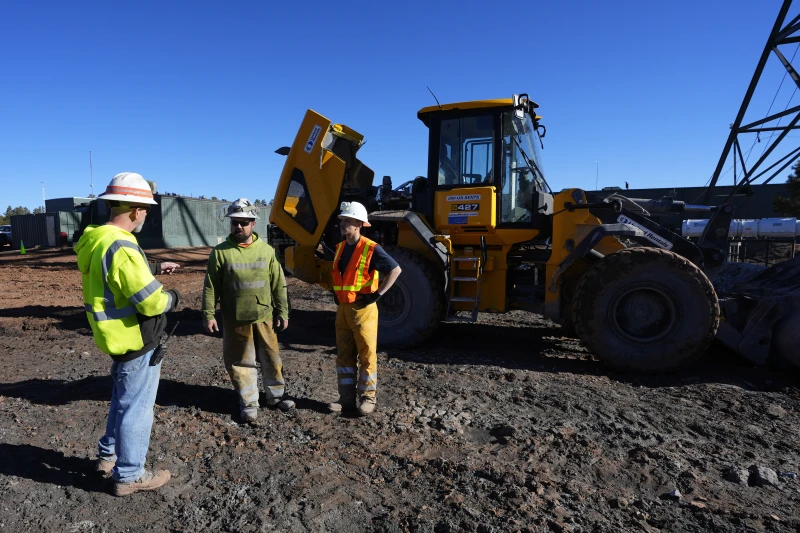The United States, a nation with a complex history intertwined with nuclear energy, is witnessing a resurgence in uranium production, particularly near the iconic Grand Canyon National Park.
This resurgence comes at a time of global instability and increasing demand for uranium, driven by a push towards nuclear power as a key component in the fight against climate change.
The Biden administration, along with numerous other countries, has committed to tripling the capacity of nuclear power worldwide, underscoring the importance of uranium as a vital commodity for the foreseeable future.
The project near the Grand Canyon, long contested and largely dormant since the 1980s, is now being revitalized amid this shifting landscape of energy priorities.
However, this renewed focus on uranium production has not been without its share of concerns and criticisms.
Environmentalists and Native American leaders, mindful of the historical impacts of uranium mining on communities in the West, are calling for stringent regulatory oversight to safeguard against potential negative consequences.
Proponents of the uranium project argue that modern uranium production practices are significantly different from those of the past, particularly during periods like World War II and the Cold War when nuclear arsenals were rapidly expanding.
The legacy of environmental devastation, health issues, and contamination left in the wake of earlier uranium mining endeavors looms large, casting a shadow of doubt over any new developments in this sector.
The Pinyon Plain Mine, located near the South Rim entrance of the Grand Canyon within the Baaj Nwaavjo I’tah Kukv National Monument, represents a focal point of this renewed activity.
Designated as a national monument by President Joe Biden in August, the mine’s operations have been allowed to proceed due to Energy Fuels Inc.’s valid existing rights.
The company asserts that the project will have minimal environmental impact and poses no risk to groundwater, emphasizing the importance of responsible resource extraction practices in the modern era.
With a planned operational footprint of just 17 acres over a period of three to six years, the Pinyon Plain Mine is projected to produce at least 2 million pounds of uranium.
This quantity of uranium is deemed sufficient to power the entire state of Arizona for a year with clean, carbon-free electricity, highlighting the potential energy benefits associated with nuclear power generation.
As the United States embarks on this new chapter in its uranium production narrative, striking a delicate balance between energy needs, environmental stewardship, and community well-being remains paramount.

The complexities surrounding uranium mining, especially in sensitive areas like the Grand Canyon region, underscore the importance of robust regulatory frameworks, transparent communication, and proactive engagement with stakeholders to ensure that the benefits of nuclear energy are realized while mitigating potential risks and safeguarding the interests of all involved parties.
The global landscape for clean, carbon-free nuclear energy is evolving, with a notable shift in the United States away from Russian uranium supply towards domestically sourced uranium.
This transition has sparked a surge in demand for uranium mining within the country, as highlighted by Moore, an industry expert. Energy Fuels, a key player in this sector, has been instrumental in meeting this demand, having contributed significantly to the production of uranium in the U.S. over the past five years.
The company’s recent contract to supply uranium concentrates to the U.S. government underscores its pivotal role in establishing the nation’s strategic reserve against potential supply disruptions.
The extraction of ore from the Pinyon Plain Mine, slated for processing at Energy Fuels’ mill in White Mesa, Utah, represents a critical step in meeting the escalating need for uranium.
However, amidst this growing appetite for uranium, concerns have been raised by a coalition of Native Americans regarding the impact of mining activities on marginalized communities and sacred lands.
In a poignant plea before the Inter-American Commission on Human Rights, representatives from Native American tribes urged the U.S. government to revise outdated mining laws and prevent further exploitation of vulnerable populations.
Carletta Tilousi, a former member of the Havasupai Tribal Council, emphasized the relentless efforts made by her community to engage with regulatory authorities and lawmakers to address their concerns regarding mining operations near the Grand Canyon.
The Havasupai Tribe, whose reservation lies in the vicinity of the proposed mine, expressed deep apprehension about the potential environmental repercussions, particularly on water sources, wildlife, and cultural heritage sites.
The conflict surrounding the Pinyon Plain Mine underscores a broader struggle between energy development interests and the preservation of sacred lands.
The Havasupai Tribe’s assertion that mining activities could jeopardize their water supply, rooted in aquifers beneath the mine, highlights the complex interplay between economic interests and environmental conservation.
Collaborative efforts between the U.S. Geological Survey and the Havasupai Tribe to assess contamination risks further underscore the multifaceted nature of this issue, encompassing health, cultural, and ecological dimensions.

The controversy surrounding the Pinyon Plain Mine is compounded by its historical legacy, having been permitted in 1984 and subsequently grandfathered into legal operation despite a moratorium on uranium mining in the Grand Canyon region.
The mine’s compliance with environmental regulations and permitting processes, as affirmed by state authorities and the U.S. Forest Service, has been a point of contention among stakeholders, with divergent views on the adequacy of existing safeguards.
Moore, representing Energy Fuels, defended the company’s practices, emphasizing their adherence to scientific standards and regulatory requirements.
The portrayal of mining companies as vilified entities in the midst of environmental debates underscores the polarized nature of discussions around energy development and conservation.
The clash between economic imperatives and environmental concerns epitomizes the broader challenges facing policymakers, industry stakeholders, and indigenous communities in navigating the complex terrain of resource extraction and land stewardship.
In conclusion, the case of the Pinyon Plain Mine encapsulates the intricate interplay between energy production, indigenous rights, environmental protection, and regulatory oversight.
As the demand for uranium continues to rise, striking a balance between economic development and environmental sustainability remains a pressing challenge.
Addressing the concerns raised by Native American communities and environmental advocates necessitates a nuanced approach that acknowledges the diverse interests at stake and seeks to forge collaborative solutions that uphold principles of equity, conservation, and responsible resource management.

The ongoing discourse surrounding environmental reviews conducted within the context of permitting processes for mining operations near national parks has sparked significant debate and concern among various stakeholders.
While assessments have indicated that the mine’s activities are unlikely to directly impact park visitors, local residents, or the groundwater and springs associated with the park, environmentalists have raised broader questions regarding the Biden administration’s stance on nuclear power policies.
The Trump administration, through the U.S. Commerce Department, emphasized the importance of domestic nuclear production for national security reasons, highlighting the role of nuclear energy in both maintaining the country’s nuclear arsenal and sustaining electricity generation from commercial reactors.
Despite criticisms and reservations from environmental groups, the Biden administration has maintained its support for nuclear power, evident in its substantial investments in modernizing nuclear defense capabilities and providing financial assistance for the reactivation of a Michigan power plant.
However, critics, such as Taylor McKinnon from the Center for Biological Diversity, have expressed skepticism about the administration’s commitment to environmental justice, particularly in light of decisions that could potentially impact communities near mining sites like the Grand Canyon.
The debate surrounding the use of nuclear power to meet emissions reduction targets is particularly contentious in the western United States, where tribal communities have historically faced challenges and environmental injustices related to uranium mining and its aftermath.
Instances of abandoned mines, contamination, and inadequate cleanup efforts have left lasting scars on communities such as the Navajo Nation, the Ute Mountain Ute, and the Oglala Lakota homelands.
The legacy of uranium mining on the Navajo Nation is especially troubling, with recent additions of mine complexes to the federal Superfund list and the memory of the largest radioactive accident in U.S. history in 1979, which had devastating consequences for local water sources, livestock, and downstream communities.
Testimonies from individuals like Teracita Keyanna underscore the deep-seated grievances and frustrations of affected communities, who feel marginalized and neglected by regulators and government agencies in addressing the persistent environmental hazards they face.
The political landscape surrounding nuclear power in Congress reflects a mix of support and opposition, with bipartisan backing for nuclear energy countered by resistance from lawmakers representing communities impacted by nuclear contamination.
Congresswoman Cori Bush’s impassioned plea to address the legacy of nuclear waste in minority communities, drawing attention to the environmental injustices in her district stemming from past uranium refining activities, highlights the urgent need for accountability and remediation efforts before further expansion of nuclear energy initiatives.
As the dialogue continues, the intersection of environmental concerns, public health impacts, and social equity considerations remains at the forefront of the debate on the future of nuclear power in the United States.

